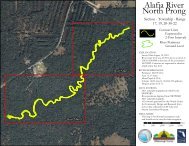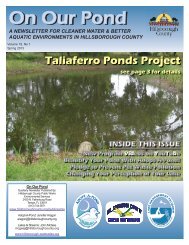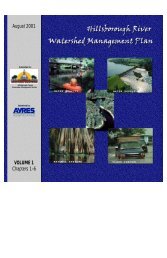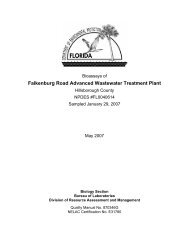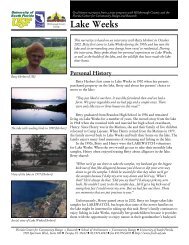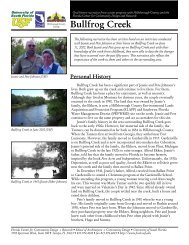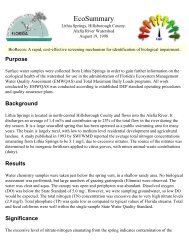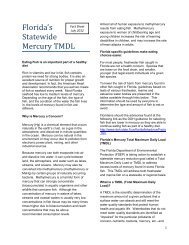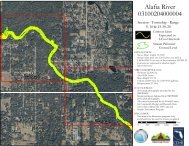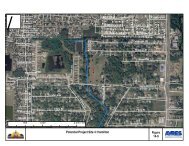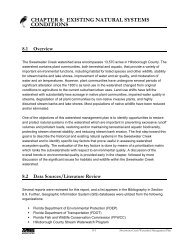Rocky Brushy Creek Watershed Mgmt. Plan (2007) -- Part 2
Rocky Brushy Creek Watershed Mgmt. Plan (2007) -- Part 2
Rocky Brushy Creek Watershed Mgmt. Plan (2007) -- Part 2
Create successful ePaper yourself
Turn your PDF publications into a flip-book with our unique Google optimized e-Paper software.
EXISTING NATURAL SYSTEMS CONDITIONSgeographic proximity. In The <strong>Rocky</strong> <strong>Creek</strong> - <strong>Brushy</strong> <strong>Creek</strong> watershed, typical species include:sawgrass, cattail, arrowhead, maidencane, buttonbush, cordgrass, soft rush, and fire flag. Thespecies composition of freshwater marsh habitat often occurs in zones and is dependent upon soiltype, hydroperiod, water depth, and successional stage (Wolfe and Drew, 1990).Saltwater marsh (642)The areal coverage of this habitat hasremained stable at about 1.1% of thewatershed over the period 1950-2004.This land cover type is particularlyvaluable as habitat for invertebrates andjuvenile fish and as a protective barrierfrom storm surges. In <strong>Rocky</strong> <strong>Creek</strong> -<strong>Brushy</strong> <strong>Creek</strong> watershed, saltwatermarshes exist in the <strong>Creek</strong>’s estuarywhere by far the most common plantspecies is black needle rush; somecordgrass is also present. Significanthabitat for juvenile fish and invertebratesof commercial importance, the saltwatermarsh in the <strong>Rocky</strong> <strong>Creek</strong> - <strong>Brushy</strong> <strong>Creek</strong> estuary has been impacted by transportation facilitiesand untreated stormwater runoff.Wet prairies (643)Formerly (1950) occupying 0.9% of the land in the <strong>Rocky</strong> <strong>Creek</strong> - <strong>Brushy</strong> <strong>Creek</strong> watershed, the wetprairie community currently (2004) covers 0.6% of the watershed. Wet prairies are usually open,mixed grass-sedge associations, which occur in areas of periodic flooding and are distinguishedfrom marshes as having shorter herbaceous species and longer, drier hydroperiods (Wolfe andDrew, 1990). Like freshwater marshes, wet prairies support a diversity of species, and eachsystem may be different from a neighboring system. Important species in the <strong>Rocky</strong> <strong>Creek</strong> - <strong>Brushy</strong><strong>Creek</strong> watershed wet prairie systems include: spike rushes, beak rushes, St. John’s wort, yelloweyedgrass, whitetop sedge, pink sundew, early whitetop fleabane, and meadow beauty.Emergent aquatic vegetation (644)The areal coverage of emergent aquatic vegetation in the <strong>Rocky</strong> <strong>Creek</strong> - <strong>Brushy</strong> <strong>Creek</strong> watershedincreased from 0.1% to 0.4% of the watershed over the period 1950 – 2004. Typically, this habitatis associated with the deepwater portions of freshwater marshes and includes species such aswater lettuce, spatterdock, water hyacinth, duckweed, and water lilies.Tidal flats/submerged shallow platform (651)This habitat type occupies the lower reaches of <strong>Rocky</strong> <strong>Creek</strong> - <strong>Brushy</strong> <strong>Creek</strong>. It represents achallenging, but biologically productive area that is important as habitat for animals that are criticallinks in the estuarine food webs. Vegetation occurring here is very sparse, and the area may8-12<strong>Rocky</strong>/<strong>Brushy</strong> <strong>Creek</strong> <strong>Watershed</strong> Management <strong>Plan</strong>



